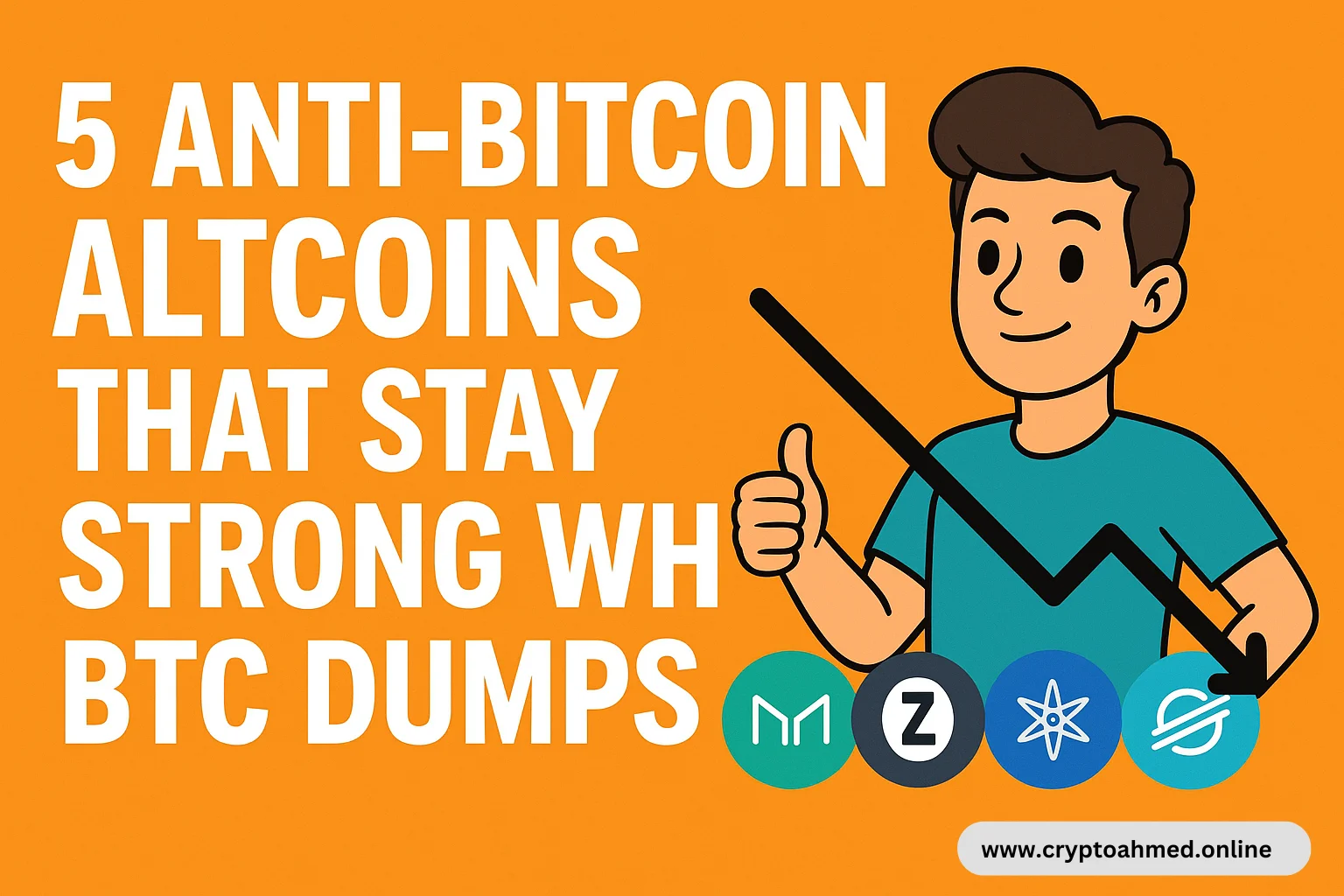Usually, most altcoins tend to follow Bitcoin’s price movement very closely. When Bitcoin starts to dump or goes through a correction phase, the majority of altcoins drop even harder. This happens because Bitcoin sets the overall market sentiment — when it falls, investors panic, and the selling pressure spreads across the entire crypto market.
However, not all altcoins react in the same way. There are a few coins that are less dependent on Bitcoin’s movement. These coins often show stronger stability during market corrections and recover more quickly when the trend reverses.
For Example, if Bitcoin falls by 5%, many altcoins might crash by 10% or more. But certain altcoins only experience a small decline — maybe just 1% or 2%. These coins have stronger fundamentals, unique ecosystems, or independent demand that helps them stay more stable compared to others. Some of them are connected to decentralized finance (DeFi), artificial intelligence (AI), or blockchain infrastructure projects that continue to perform well even when Bitcoin struggles.
In this blog, I’ll share the top 5 altcoins that don’t always follow Bitcoin’s movements and can maintain their position even in a bearish market. If you understand these projects properly, they might become valuable additions to your portfolio — especially when the overall crypto market turns unstable.
Note: This content is for educational purposes only and should not be taken as financial advice. The cryptocurrency market is extremely volatile, and prices can change rapidly. Always do your own research before making any investment decisions, and remember to invest only what you can afford to lose.
Top 5 ANTI BTC ALT Coin
1. Maker (MKR)

Maker is the governance token behind the MakerDAO protocol, one of the first and most established decentralized finance (DeFi) systems on Ethereum. MakerDAO is best known for issuing DAI, a stablecoin that’s soft-pegged to the U.S. dollar and backed by crypto collateral. This stability mechanism often gives Maker a slightly more independent market behavior compared to Bitcoin, as its value is tied to activity and demand within the DeFi ecosystem rather than pure market sentiment.
When Bitcoin prices fall sharply, traders often move funds into stablecoin ecosystems like DAI for safety, indirectly benefiting Maker. Because MKR holders play a role in maintaining DAI’s peg and managing the protocol’s collateral system, Maker’s price can sometimes rise during broader market downturns if DeFi activity remains strong. Still, MKR isn’t immune to crypto-wide selloffs, but it has shown relative resilience compared to speculative altcoins.
2. Zcash (ZEC)

Zcash is a privacy-focused cryptocurrency designed to offer users the choice between transparent and shielded transactions. It uses advanced cryptography (zero-knowledge proofs) to protect transaction data while maintaining blockchain integrity. This privacy feature gives Zcash a unique position in the crypto world, often attracting investors looking for anonymity during uncertain times or when regulatory pressures mount on mainstream coins like Bitcoin.
Because of its distinct use case, Zcash sometimes behaves differently from the broader market. When Bitcoin faces scrutiny or legal risk narratives rise, privacy coins like ZEC occasionally gain traction as alternatives. However, Zcash’s smaller market cap and limited exchange listings make it more volatile, meaning while it may not mirror Bitcoin’s dumps exactly, it can experience sharp moves in either direction.
3. Cosmos (ATOM)

Cosmos is a blockchain ecosystem focused on interoperability — connecting multiple blockchains so they can exchange information and tokens. Its core technology, the Inter-Blockchain Communication (IBC) protocol, allows various chains to communicate, giving Cosmos a strong position in the growing multi-chain future of crypto. Because its adoption depends on technical development and network partnerships, ATOM’s price sometimes moves independently of Bitcoin’s cycles.
Investors view Cosmos as a “builder’s blockchain,” which means its value often reacts more to ecosystem growth and updates than to Bitcoin’s price swings. When BTC dumps due to macro or speculative reasons, Cosmos can maintain better stability if developer activity and staking yields remain strong. Still, correlation can return in severe bear markets, as liquidity leaves all crypto assets together.
4. Tezos (XTZ)

Tezos is a smart contract platform built around the idea of on-chain governance and upgradability. Unlike many blockchains that require hard forks to evolve, Tezos can upgrade itself through its consensus mechanism, making it attractive to institutions and developers who value long-term flexibility. This unique design often keeps it more insulated from Bitcoin’s day-to-day market mood.
XTZ’s price movements are often driven by ecosystem upgrades, NFT adoption, and partnerships rather than speculation tied to BTC. During Bitcoin downturns, Tezos can hold steadier if there’s ongoing developer activity or strong staking participation. However, as with most altcoins, extreme Bitcoin crashes still tend to pull liquidity away from all crypto assets — Tezos included.
5. Stellar (XLM)

Stellar is a blockchain platform designed for fast, low-cost cross-border payments and financial inclusion. Founded by Jed McCaleb (a Ripple co-founder), Stellar focuses on real-world financial integration, helping institutions and individuals send digital assets across borders efficiently. This practical use case gives it an independent narrative separate from the typical speculative hype surrounding Bitcoin.
When Bitcoin’s volatility drives traders out of riskier assets, Stellar’s payment-focused use case can help it maintain more stability, especially if there’s growing adoption among fintech firms or global remittance providers. While it’s not entirely immune to Bitcoin market cycles, XLM’s correlation with BTC is often weaker than pure speculative altcoins because of its real-world utility and established network partnerships.
Related Content
- How to Create Accurate Crypto Signals for Any Altcoin
- Top AI-Powered Altcoins Changing the Future of Blockchain Technology
- Path of Alt-Season Explained: Why Altcoins Are the Next Big Crypto Opportunity
- The Ultimate Checklist Before Investing in Any Crypto Coin
Conclusion
While no cryptocurrency is completely immune to Bitcoin’s market swings, some projects have shown the ability to hold their ground better during BTC downturns. Coins like Maker, Zcash, Cosmos, Tezos, and Stellar offer unique use cases, strong fundamentals, and ecosystems that aren’t entirely dependent on Bitcoin’s price action. Their performance often relies more on real-world utility, protocol development, or niche demand rather than speculative hype.
For investors, these altcoins can add diversification to a crypto portfolio, especially when Bitcoin faces volatility. However, it’s important to remember that the crypto market remains highly interconnected. Even the most “anti-Bitcoin” coins can experience short-term drops when market sentiment turns negative. A balanced approach — with research, risk management, and long-term perspective — is key to navigating these shifts successfully.

